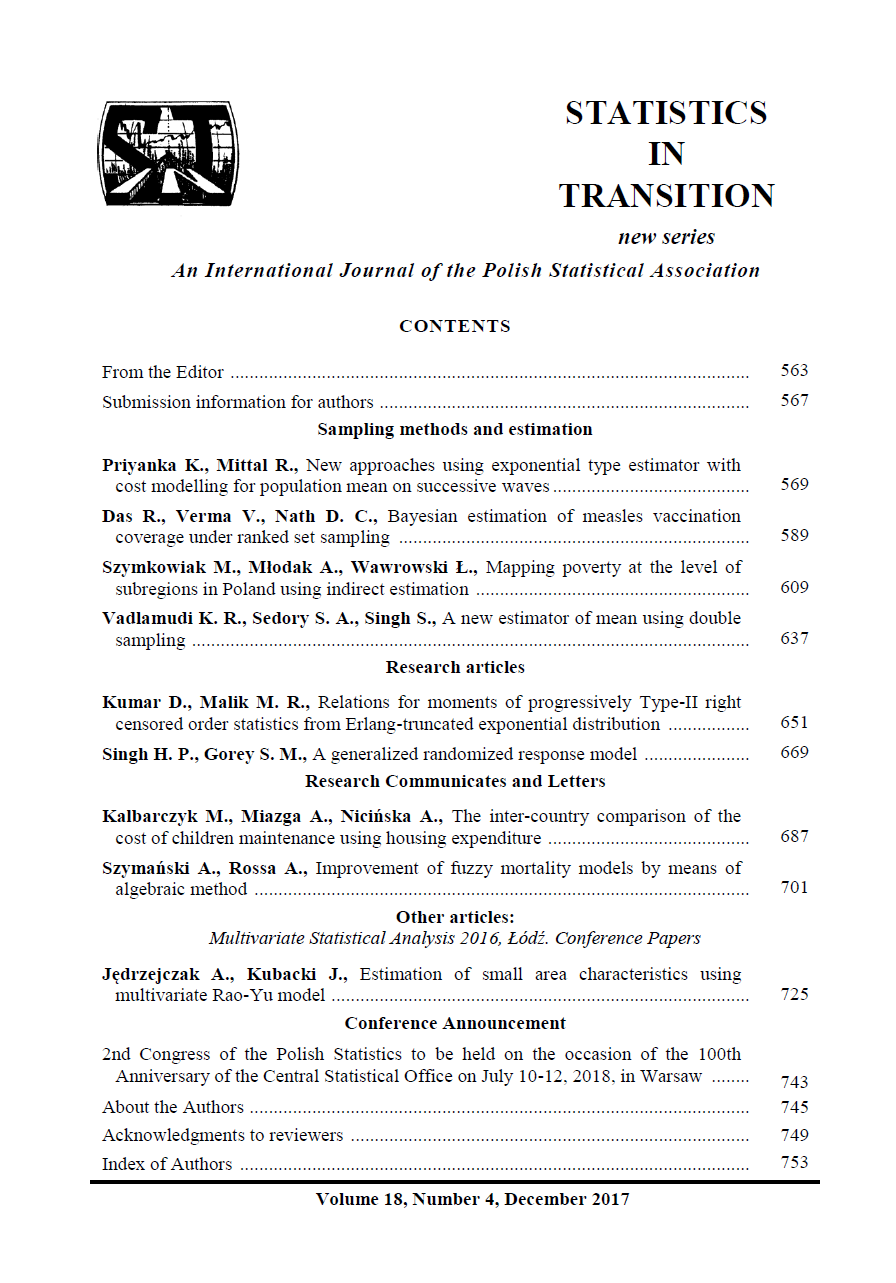ARTICLE
ABSTRACT
The forecasting of mortality is of fundamental importance in many areas, such as the funding of public and private pensions, the care of the elderly, and the provision of health service. The first studies on mortality models date back to the 19th century, but it was only in the last 30 years that the methodology started to develop at a fast rate. Mortality models presented in the literature form two categories (see, e.g. Tabeau et al., 2001, Booth, 2006) consisting of the so-called static or stationary models and dynamic models, respectively. Models contained in the first, bigger group contains models use a real or fuzzy variable function with some estimated parameters to represent death probabilities or specific mortality rates. The dynamic models in the second group express death probabilities or mortality rates by means of the solutions of stochastic differential equations, etc.
The well-known Lee-Carter model (1992), which is widely used today, is considered to belong to the first group, similarly as its fuzzy version published by Koissi and Shapiro (2006). In the paper we propose a new class of fuzzy mortality models based on a fuzzy version of the Lee-Carter model. Theoretical backgrounds are based on the algebraic approach to fuzzy numbers (Ishikawa, 1997a, Kosiński, Prokopowicz and Ślęzak, 2003, Rossa, Socha and Szymański, 2015, Szymański and Rossa, 2014). The essential idea in our approach focuses on representing a membership function of a fuzzy number as an element of C* - Banach algebra. If the membership function µ(z) of a fuzzy number is strictly monotonic on two disjoint intervals, then it can be decomposed into strictly decreasing and strictly increasing functions Φ(z), Ψ(z), and the inverse functions f(u)=Φ-1 (u) and g(u)=Ψ-1 (u), u ∈ [0, 1] can be found.
Ishikawa (1997a) proposed foundations of the fuzzy measurement theory, which is a general measurement theory for classical and quantum systems. We have applied this approach, termed C* -measurement, as the theoretical foundation of the mortality model. Ishikawa (1997b) introduced also the notions of objective and subjective C* -measurement called real and imaginary C* -measurements. In our proposal of the mortality model the function f is treated as an objective C* -measurement and the function g as an subjective C* -measurement, and the membership function µ(z) is represented by means of a complex-valued function f(u) + ig(u), where i is the imaginary unit. We use the Hilbert space of quaternion algebra as an introduction to the mortality models.
KEYWORDS
C * -Banach algebra, non-commutative C* -algebra, quaternion algebra, fuzzy mortality model.
REFERENCES
BOOTH, H., (2006). Demographic forecasting: 1980 to 2005 in review, International Journal of Forecasting, 22, pp. 547–581.
ISHIKAWA, S., (1997a). Fuzzy inferences by algebraic method, Fuzzy Sets and Systems, 87, pp. 181–200.
ISHIKAWA, S., (1997b). A quantum mechanical approach to a fuzzy theory, Fuzzy Sets and Systems, 90, pp. 277–306.
KOISSI, M.-C., SHAPIRO, A. F., (2006). Fuzzy formulation of the Lee-Carter model for mortality forecasting, Insurance: Mathematics and Economics, 39, pp. 287–309.
KOSIŃSKI, W., PROKOPOWICZ, P., ŚLĘZAK, D., (2003). Ordered Fuzzy Numbers, Bull. Polish Acad. Sci. Math., 51, pp. 327–338.
LEE R. D., CARTER, L., (1992). Modeling and forecasting the time series of U.S. mortality, Journal of the American Statistical Association, 87,pp. 659–671.
NASIBOV, E., PEKER, S., (2011), Exponential Membership Function Evaluation based on Frequency, Asian Journal of Mathematics and Statistics, 4 (1), pp. 8–20.
WILMOTH, J. R., HORIUCHI, S., (1999). Rectangularization revised: variability of age at death within human populations, Demography, 36 (4), pp. 475–495.
ROSSA, A., SOCHA, L., SZYMAŃSKI, A., (2015). Hybrydowe modelowanie umieralności za pomocą przełączających układów dynamicznych i modeli rozmytych, (in Polish), University of Lodz Press.
SZYMAŃSKI, A., ROSSA, A., (2014). Fuzzy mortality model based on Banach algebra, International Journal of Intelligent Technologies and Applied Statistics, 7, pp. 241–265.
TABEAU, E., BERG JETHS, A., HEATHCOTE, CH., (eds.), (2001). Forecasting of mortality in developed countries: insights form a statistical, demographic and epidemiological perspective, Kluwer Academic Publishers, London
